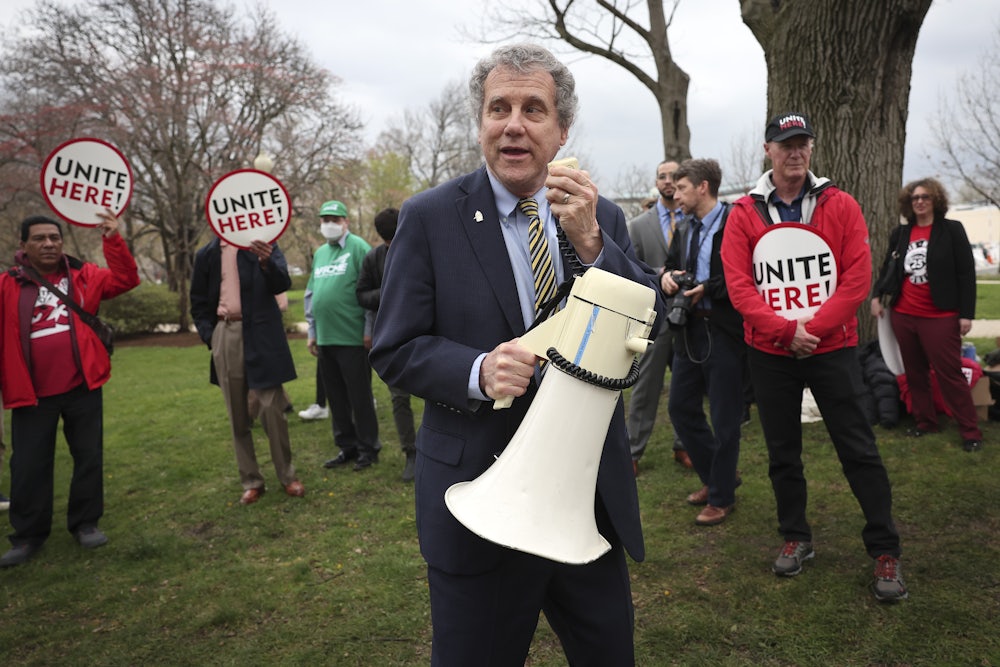There’s an old saying in politics: Run scared or run unopposed. And in Ohio—ruby red Ohio, according to conventional wisdom—Senator Sherrod Brown surely has to be running scared. After all, Donald Trump has won Ohio twice, by around a very comfortable eight points both times. And below the presidential level, things haven’t gone any better for Brown’s party. Other than Brown himself, there are no Democrats holding any statewide office (outside of the state’s Supreme Court, which is another story). In the House of Representatives, just five of the Buckeye State’s 15 members are Democrats.
For months, the conventional wisdom has been that Brown is one of the two most endangered Senate Democratic incumbents, along with Montana’s Jon Tester. And while Brown is a Democratic favorite for his emphasis on populist, working-class economics, there’s even more at stake for Democrats than Brown’s personal fate: If he can’t hold off GOP challenger Bernie Moreno, his party’s chances of holding its Senate majority are roughly zero, and any legislative agenda of a potential President Kamala Harris is basically dead.
And yet, some recent candidates’ nights offer a different perspective on one of the most competitive—and without doubt the most expensive, clocking in at a mind-blowing $400 million so far—Senate races in the country.
At a county farm bureau event held September 24 in an historic barn that’s been converted into a rustic meeting center in Westerville, Ohio, a suburban city just north of Columbus, a dozen candidates or their representatives gathered to present their cases to what should have been a Republican-friendly audience. Ten of the candidates were running for Statehouse seats, one candidate was a county clerk (who is running unopposed) and the twelfth was agricultural advocate Tony Logan, CEO of Agrivoltaics, “where farming meets solar,” who was there as a proxy for Brown.
Brown, Ohio’s first senator on the Agriculture Committee in more than 40 years, put provisions in the 2018 farm bill, for example, to improve water quality in Ohio, ensure that taxpayer support targeted local farmers and not agribusinesses, and connect rural Ohioans to high-speed internet. Logan also said that Brown has worked to protect American farmland from being bought by China.
When we think of natural Brown voters, we think more of factory workers than farmers. But it’s also the case that, unlike some Democrats, Brown has always worked counties that he knows he’s going to lose. “Sherrod has been around so long, he’s had a lot of time to do a lot of things for farmers,” said Michael F. Curtin, the former editor and associate publisher of The Columbus Dispatch. Curtin spent most of his newspaper career covering state and local politics and gained national prominence running the newspaper’s unerringly accurate political polls. “It’s part of an 88-county strategy. You don’t concede any counties. You know you’ll lose some, but if you work it, you can cut that loss.”
Over the years, Brown has won a dwindling number of Ohio’s 88 counties. In his first Senate run in 2006, he was victorious in 47 counties; in 2012, he took 25 counties; and in 2018, that was down to just 16 counties. So Brown is losing a lot of counties. But importantly, he’s not losing them by as much as most other Democrats do. For example, in the counties bordering West Virginia along the Ohio River, Brown lost in 2018, but he scored in the 40s in counties like Jefferson, Belmont, and Monroe. In 2020, Biden was in the 20s in those counties. Those votes add up.
“I think it’s about slowing or reversing his declines in some of the core northeast and north Ohio counties, like Lorain and Lake,” said Molly O’Shaughnessy, a Columbus-based managing principal at Democratic polling and strategy firm EMC Research. Lorain and Lake, which flank Cleveland, are both counties that Brown won and Biden lost. She continued, “Sherrod has lost ground over the years, so can he slow or reverse that? He doesn’t necessarily need to flip counties, just chip away at them.”
Jan Allen, who was a senior staff member for Richard F. Celeste, the last Democrat to serve two terms as Ohio governor, agrees. “I know what they’re doing,” Allen said. “They’re localizing all that he has done either for this county or that group. That’s real stuff. You don’t make that up—and he’s got enough campaign infrastructure to localize that way.”
At another candidates’ night, held by 100 Black Women Columbus at Columbus Recreation and Parks headquarters, a wide range of politicians attended, including a Republican candidate for county prosecutor who is so extreme that the county GOP has unendorsed him, as well as a Libertarian running for a Statehouse seat. Also in attendance was an African American woman who spoke movingly about how Brown’s leadership had affected her life. Once again, no one from Moreno’s camp showed up.
Moreno is part of a notoriously untrusted group—car salesmen—and has at times become his own worst enemy during this campaign. For example, he was recently in Chillicothe, in red Ross County due south of Columbus, where he attempted to paint Brown as an out-of-touch Washington liberal, scoffing that local citizens probably hadn’t seen Brown in quite a while. In fact, Brown has been in Chillicothe often, and locals gratefully credit him with saving the city’s Veterans Affairs hospital from closure.
Even more eye-popping were Moreno’s remarks at a now-notorious town hall. In what may explain why he has skipped other such events, the Trump-endorsed businessman placed his foot firmly in his mouth, saying he doesn’t think abortion is “an issue” for women who are older than 50.
“You know, the left has a lot of single-issue voters,” Moreno said. “Sadly, by the way, there’s a lot of suburban women, a lot of suburban women that are like, ‘Listen, abortion is it. If I can’t have an abortion in this country whenever I want, I will vote for anybody else.’ OK. It’s a little crazy, by the way, but—especially for women that are like past 50—I’m thinking to myself, ‘I don’t think that’s an issue for you.’”
Brown immediately turned the remarks into a commercial. Abortion hadn’t featured prominently in the race up to that point. But Moreno’s remarks put the issue right back in the spotlight. Such missteps, as well as his absence from meet-the-candidate events, indicate that Moreno’s strategy seems to be to rely solely on riding Trump’s coattails, much as JD Vance relied on the ex-president’s backing to win Ohio’s other U.S. Senate seat in 2022. “Moreno isn’t talking to Dems or swing voters, but Trump voters,” Allen said.
That could prove to be a costly mistake. While Vance’s victory in the 2022 race has been seen as proof of Trump’s domination of the state, it’s important to note that Vance ran well behind the man at the top of the ticket. Mike DeWine, who was not a rabid MAGA supporter and who notably partnered with health director Amy Acton, a Democrat, to wage an early bipartisan fight against the coronavirus, was reelected as governor with 62 percent of the vote. In a time in which ticket-splitting is increasingly rare, DeWine’s long coattails enabled all other statewide Republicans to win handily—that is, all except for JD Vance, who with 53 percent of the vote underperformed every Republican on the ticket.
Given all this, it’s little wonder that Ohio Democrats—and campaign officials—are feeling at least cautiously optimistic about Brown’s chances. Curtin, the former Dispatch editor, says, “There hasn’t been a poll yet that shows Sherrod behind. He’s had an incredible portfolio of ads, with a lot of cross-party appeal.”
The more intriguing question is if there’s a way for Harris to not just lose by five or six points in Ohio (and call it a moral victory) but to actually eke out a win in the Buckeye State.
A New York Times/Siena College poll published on September 28 showed that, given a ballot that includes such third-party folks as the Green Party’s Jill Stein and Libertarian Chase Oliver, Harris drew 44 percent and Trump got 47 percent.
But most polls show Trump with a more comfortable lead. As with Brown, turnout will be critical to any chance of a surprise Harris victory. If turnout is through the roof in Cuyahoga, Franklin, Hamilton, and a few other blue counties, Harris may have a chance. But failing that, a win for Brown, who, if other results tumble the Democrats’ way, might be that crucial fiftieth or fifty-first Senate vote for Harris’s agenda, will constitute victory enough.






